特別展「始皇帝と大兵馬俑」
-

将軍俑 秦時代・前3世紀 秦始皇帝陵博物院蔵
2015年12月11日(金)、入場者が20万人に達しました。
2015年11月20日(金)、入場者が10万人に達しました。
1089ブログ「始皇帝と大兵馬俑」 展覧会の見どころなどを紹介しています。
「永遠」を守る軍団、参上! 人気No1はどのYo? 投票結果(投票期間:2015年10月13日(火)~12月20日(日))
東京国立博物館 資料館 特別展「始皇帝と大兵馬俑」関連図書コーナー設置
展覧会のみどころ
1 秦王朝の軌跡 周辺の小国から巨大帝国へ
現在の中国甘粛(かんしゅく)省南部にあった小国・秦は、春秋時代になると、陝西(せんせい)省の関中盆地に東遷します。そこはかつて天下に君臨した西周王朝(紀元前11~前8世紀)が都を置いた特別な場所でした。西周から受け継いだ肥沃な大地は、秦を経済的な意味だけでなく、政治的な意味においても強国とする基盤となりました。
国外の有能な人材を積極的に登用し「富国強兵」を推し進めた秦は、やがて魏や楚といった強国と競合するほどの勢力に成長しました。また、秦の西方と北方に暮らしていた「西戎(せいじゅう)」「匈奴(きょうど)」と呼ばれた民族とも積極的に交流し、金・銀などの富や強力な馬を得ていたものと考えられます。
辺境の一小国だった秦が天下統一に向かって成長していく過程について、秦とライバル国、「西戎」「匈奴」、さらには西周王朝との関わりを物語る青銅器・金銀器・土器などを通して辿ります。始皇帝や兵馬俑の出現を予感させる、春秋・戦国時代における秦のダイナミックな歴史の展開をお楽しみください。
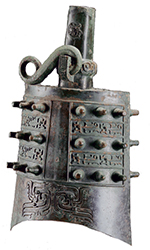
春秋時代・前8~前5世紀 宝鶏市陳倉区楊家溝太公廟村出土
宝鶏青銅器博物院蔵
秦初期の歴史を伝える鐘
大きさの異なる6 個の鐘のセット「編鐘」のうち、2 番目に大きな鐘です。別の1番大きな鐘とこの鐘の表面に秦の君主の作った銘文が連続して鋳こまれています。
まず別の鐘で秦初期の歴代君主の功績を讃え、次にこの鐘で先祖の加護と秦の領土拡大を祈っています。秦初期の歴史を伝える数少ない出土文字資料として貴重なものです。
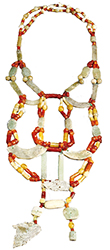
西周時代・前10~前9世紀 扶風県強家村出土
宝鶏市周原博物館蔵
あこがれのアクセサリー
孤形や動物形に彫った玉と、瑪瑙の管や珠などを綴った胸飾りです。やわらかく緑がかった玉の光沢と、瑪瑙の鮮やかな赤とのコントラストが目を引きつけます。かつて天下に君臨した西周王朝で王侯が高い身分の象徴として身につけたものです。春秋時代の秦は、西周の青銅器や玉器にあこがれ、その多くを取り入れました。
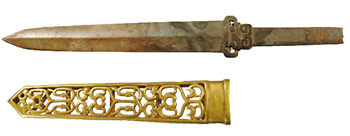
玉剣・金剣鞘
春秋時代・前8~前7世紀 韓城市梁帯村27号墓出土
韓城市梁帯村古墓葬群文物保護管理所蔵
北方草原とつながる豪華な短剣
玉を磨いて作った短剣と、その金製の鞘です。短剣は刃部と柄の境界に獣面文が彫られ、鞘は龍のような文様が透彫りで飾られています。これらは芮という秦に隣接した国のものですが、青銅製で同形の短剣と金器は、秦とともに、北方草原の墓でも出土します。秦とその周辺、および北方草原とのつながりを物語る貴重な作品です。
2 始皇帝の実像 発掘された帝都と陵園
競合する国々を滅ぼし中国で初めて「皇帝」になった始皇帝は、それまで国によって異なっていた度量衡(どりょうこう)、貨幣などを統一し、新たな支配体制を確立しました。こうした始皇帝による統一事業の数々を、出土した重りや量りなどの出土品によって紹介します。
また、帝都・咸陽(かんよう)の賑わいのほか、咸陽宮殿と始皇帝陵園(りょうえん)の壮大なスケールにも、発掘された巨大な建材や壁画から迫ります。始皇帝の生前のすまいが咸陽宮殿であれば、陵園は死後のすまいといえる施設です。これらの遺跡から出土した建材のなかには、皇帝、つまり王を超えた存在として天下に君臨した始皇帝のすまいにふさわしい工夫や装飾を見てとれるものがあります。兵馬俑だけでは読みとれない、宮殿や陵園の出土品が物語る始皇帝の新しい実像が見えてきます。

戦国~秦時代・前3世紀 咸陽市咸陽宮殿址出土
秦咸陽宮遺址博物館蔵
高度なインフラ技術
組み合わせ式の陶製の水道管。大きな漏斗状のものとL字形のものが連結し、さらに円筒状の管を横方向に連続させて地下に水を流しました。表面に施された縄目の模様は製作時に付けられた工具の痕です。同様の導水施設は始皇帝陵園をはじめ咸陽宮殿以外でも発見されており、秦の高度なインフラ整備の様子がうかがえます。

秦時代・前3世紀 出土地不詳
秦始皇帝陵博物院蔵
「権」力の重さはどれくらい?
始皇帝は、天下統一の後、重量単位を統一するため、重量の規準となる重り(権)を多数作らせました。この権は青銅製で、側面に始皇帝による度量衡統一の詔勅と後継ぎの二世皇帝による詔勅に関する銘文が刻まれているため、両詔権と呼ばれています。当時の歴史と文字を研究する上で貴重な資料です。
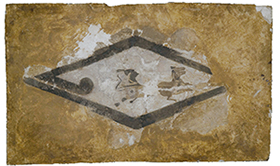
戦国~秦時代・前3世紀 咸陽市咸陽3号宮殿址出土
陝西省考古研究院蔵
東西123メートル、南北60メートルの咸陽3号宮殿は、壁面の多くに画が描かれていました。これはその残片のひとつです。黒い菱形の枠内を白く塗り、その中央に2頭立ての馬車を描いています。御者は顔こそ残っていませんが、身を前傾させて片手で鞭打つ様子が分かります。この壁画を始皇帝もかつて目にしたことでしょう。
3 始皇帝が夢見た「永遠の世界」 兵馬俑と銅車馬
兵馬俑は、全体でひとつの軍団を写したものです。そのため、将軍、歩兵、騎兵など、軍団を構成するさまざまな役割の将兵が表されています。展示会場では、兵馬俑がそれぞれもつ魅力を最大限引き出すとともに、数千もの兵馬俑が出土した発掘現場「兵馬俑坑」を再現することで、「軍団」としての兵馬俑の圧倒的な迫力をお楽しみいただけます。あわせて、始皇帝を取り巻く軍事以外の面に光を当てる発見もご紹介します。
2両の銅車馬は始皇帝が実際に乗ったと考えられる馬車を青銅で細部まで再現した模型です。今回展示するのは銅車馬の複製品ですが、約6千もの部品と彩色まで完全に写し取った出来栄えは圧巻です。輿のなかにも施された彩色の文様は、かつて始皇帝が目にしたものと同じなのかもしれません。
始皇帝はなぜ兵馬俑や銅車馬を陵墓の周囲に埋めさせたのでしょうか。その背景には、死後も皇帝として永遠に世界の支配を夢見ていた始皇帝の野望が垣間見えます。

1号銅車馬(写真左)、2号銅車馬(写真右) [展示は複製]
原品=秦時代・前3世紀 西安市臨潼区秦始皇帝陵銅車馬坑出土
秦始皇帝陵博物院蔵
始皇帝の愛車がモデル!?
2種類の4頭立て馬車をかたどった青銅製の精巧な模型で、大きさは実際の馬車の半分ほどです。表面全体に彩色を施し、馬には金・銀製の豪華な金具を着けています。1号の銅車馬は立って乗るもので、輿には絹傘を立てています。2号の銅車馬は輿のなかに座ることができ、左右両側と前方の窓は自在に開閉できます。2両とも始皇帝陵の西側の坑から出土しました。御者はいるものの、主人の姿は見えません。始皇帝の霊魂を乗せて出かけるために副葬したとする考え方もあります。
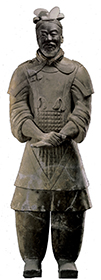
秦時代・前3世紀
西安市臨潼区秦始皇帝陵1号兵馬俑坑出土
秦始皇帝陵博物院蔵
百戦錬磨の武将
湾曲した冠と丈の長い、房飾り付きの鎧を身につけています。組んだ両手の下には、もともと剣を立てていたという説もあります。思慮深そうな眼差しとたくましい両腕に、百戦錬磨の武将ならではの風格が漂います。
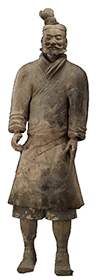
秦時代・前3世紀
西安市臨潼区秦始皇帝陵1号兵馬俑坑出土
秦始皇帝陵博物院蔵
軽装備の戦士
髷を高々と結い上げ、立派な髭をたくわえた戦士です。右前合わせの上着を革帯で留めています。歩きやすいように丈の短いズボンと脚絆を着用しています。当初は右手に弩弓を持っていたものと推測されます。

秦時代・前3世紀
西安市臨潼区秦始皇帝陵2号兵馬俑坑出土
秦始皇帝陵博物院蔵
弓の準備、完了
半身に構えて遠くを見据えています。もともと弓か弩弓に矢をつがえて待機している兵士の姿を表したものです。
鎧ではなく、上着を身にまとい革帯で留めています。動きやすい軽装備の射手です。
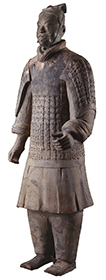
秦時代・前3世紀
西安市臨潼区秦始皇帝陵1号兵馬俑坑出土
秦始皇帝陵博物院蔵
重装備の豪傑
二の腕まで覆う重装備の鎧をまとい、頭に板状の冠を載せています。前に出した左手の角度から、当初は何らかの武器を少し傾けて持っていたものと推測されます。いかにも豪傑風の髭をもつ部隊長級の人物です。

秦時代・前3世紀
西安市臨潼区秦始皇帝陵2号兵馬俑坑出土
秦始皇帝陵博物院蔵
鋭い眼光の射手
片膝を立てて、緊張した表情で前方を見ています。攻撃命令を待っているのでしょう。もともと右側には、弩弓を携えていました。鎧を着た重装備の弓兵で、立射俑とは異なる部隊を編成していました。
© 陝西省文物局・陝西省文物交流中心
© 陝西省文物局・陝西省文物交流中心・秦始皇帝陵博物院
開催概要 |
|||||||||||||||||
| 会 期 | 2015年10月27日(火) ~ 2016年2月21日(日) | ||||||||||||||||
| 会 場 | 東京国立博物館 平成館(上野公園) | ||||||||||||||||
| 開館時間 | 9:30~17:00(入館は閉館の30分前まで) (ただし、12月18日までの金曜日、10月31日(土)、11月1日(日)・2日(月)は20:00まで開館) |
||||||||||||||||
| 休館日 | 月曜日 (ただし、11月2日(月)、11月23日(月・祝)、1月11日(月・祝)は開館。11月4日(水)、11月24日(火)、1月12日(火)は休館)、年末年始(12月24日(木)~2016年1月1日(金・祝)) |
||||||||||||||||
| 観覧料金 | 一般1600円(1400円/1300円)、大学生1200円(1000円/900円)、高校生900円(700円/600円) 中学生以下無料
|
||||||||||||||||
| 交 通 | JR上野駅公園口・鶯谷駅南口より徒歩10分 東京メトロ銀座線・日比谷線上野駅、千代田線根津駅、京成電鉄京成上野駅より徒歩15分 |
||||||||||||||||
| 主 催 | 東京国立博物館、陝西省文物局、陝西省文物交流中心、NHK、NHKプロモーション、朝日新聞社 | ||||||||||||||||
| 後 援 | 中国大使館 | ||||||||||||||||
| 協 賛 | 野崎印刷紙業 | ||||||||||||||||
| 協 力 | 全日本空輸 | ||||||||||||||||
| カタログ・音声ガイド | 展覧会カタログ(2400円)は、平成館2階会場内、および本館1階ミュージアムショップにて販売しています。音声ガイド(日本語のみ)は520円でご利用いただけます。 | ||||||||||||||||
| お問合せ | 03-5777-8600 (ハローダイヤル) | ||||||||||||||||
| 展覧会公式サイト | http://heibayou.jp/ 展覧会公式サイトは会期終了時をもって終了いたしました。 |
||||||||||||||||
関連事業
※12月7日(月)は休館日のため、上映会はありません。 当日受付
ジュニアガイド
ジュニアガイドのページへ
特別チケット 販売終了しました
販売期間が異なりますので、詳細は 特別チケットのページをご覧ください。
巡回予定
